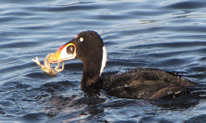Wildlife - Species

Species Specific Regulations
Surf Scoter
Licenses: Hunting License required. Migratory Bird Hunting and Conservation Stamp (Federal Duck Stamp) that is validated by the hunter signing the stamp in ink across the face of the stamp
Limits: Please see Migratory Bird Regulations for any game zones restrictions or Limitations.
Surf Scoter (Melanitta perspicillata)

Description
Drakes can be distinguished from other scoters by two white patches on their head and the bright color of the bill.
Average Size
Surf scoters have an average length of 19 1/2 inches and an average weight of 2 pounds.
Range
While the surf scoter can be found in all 4 flyways, it is most common along the coasts. Surf scoters are found along the South Carolina coastline in winter months.
Preferred Habitat
During the breeding season these scoters can be found in shallow lakes less than 10ha in size. In the winter they move to shallow marine waters with rocky substrates.
Food Habits
In freshwater surf scoters eat aquatic invertebrates, while in marine habitats they feed mostly on mollusks. They will also feed on herring eggs when available.
Reproduction
Breeding pairs form on the wintering grounds. When the pair arrives on the breeding grounds a nest is made by creating a depression in the ground and lining it with debris like moss, needles, twigs, and bark. The female then lays 6-9 creamy white eggs.
Sound
Drake makes a gurgling call and a puk-puk noise during courtship. Usually silent.
Behavior
- Like all scoters, these birds move along our coasts in loose flocks, stringing into irregular, wavy lines.
- Flight is strong, direct, usually close to the waves.
- Male defends a moving space around the female.
- Forms large flocks during winter months.
Publications and Literature
U.S. Fish & Wildlife Service, Federal Duck Stamp Office Presents: North American Waterfowl (Adobe PDF file)
Savard, Jean-Pierre L., Daniel Bordage and Austin Reed. 1998. Surf Scoter (Melanitta perspicillata), The Birds of North America Online (A. Poole, Ed.). Ithaca: Cornell Lab of Ornithology; Retrieved from the Birds of North America Online
South Carolina waterfowl hunters 16 and older are required by state law to obtain a state migratory waterfowl permit and Migratory Game Bird permit. Both permits must be in the hunter's possession while hunting or transporting legal waterfowl. A state waterfowl permit is included with the Lifetime Senior, Lifetime Gratis and Disability Licenses. S.C. residents who hold a Lifetime Senior or Lifetime Gratis License are not required to have a Migratory Game Bird permit.
National Migratory Bird Harvest Information Program (HIP)
The waterfowl permits and HIP permits are available from select DNR offices and from hunting and fishing license agents.
